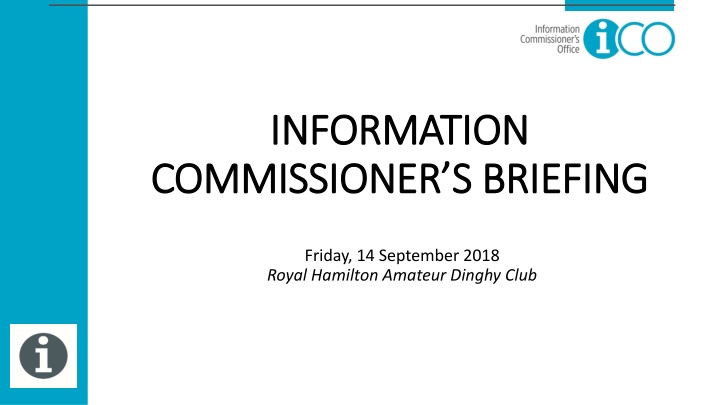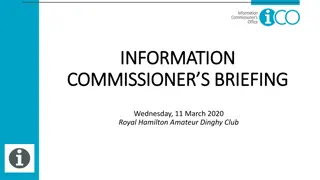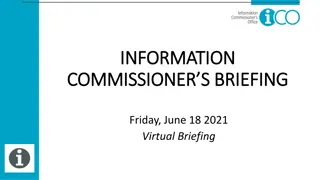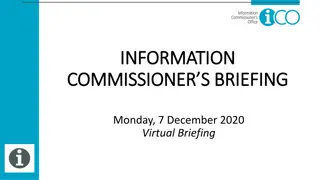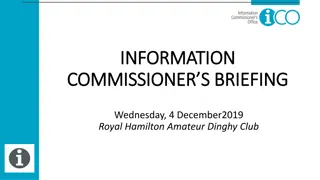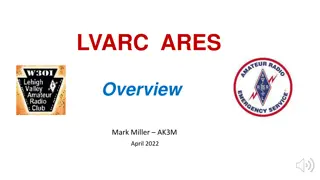Information Commissioner's Briefing at Royal Hamilton Amateur Dinghy Club
Explore the agenda, mandate, and role of the Information Commissioner, focusing on promoting rights awareness, providing guidance, and conducting reviews. Learn about PATI standards and tests, where to find them, and how decisions are made. Understand the importance for public authorities to comply with the PATI Act and document their actions effectively.
Download Presentation

Please find below an Image/Link to download the presentation.
The content on the website is provided AS IS for your information and personal use only. It may not be sold, licensed, or shared on other websites without obtaining consent from the author.If you encounter any issues during the download, it is possible that the publisher has removed the file from their server.
You are allowed to download the files provided on this website for personal or commercial use, subject to the condition that they are used lawfully. All files are the property of their respective owners.
The content on the website is provided AS IS for your information and personal use only. It may not be sold, licensed, or shared on other websites without obtaining consent from the author.
E N D
Presentation Transcript
INFORMATION INFORMATION COMMISSIONER S BRIEFING COMMISSIONER S BRIEFING Friday, 14 September 2018 Royal Hamilton Amateur Dinghy Club
AGENDA AGENDA 9:00 9:15 Introductions to ICO and Information Commissioner s Decisions Standards for Administrative Denial for Burdensome Requests Break Standards for Administrative Denial for Burdensome Requests, continued Records Management and Access to Information Wrap-up and Evaluations 9:15 10:15 10:15 10:30 10:30 11:00 11:00 11:25 11:00 11:25
Information Commissioners Mandate Information Commissioner s Mandate Promote awareness of the rights Provide guidance and oversight Conduct reviews and issue legally binding decisions
Role of the Information Commissioner Role of the Information Commissioner Decisions During PATI Request Process PATI Judicial Review & Decision Internal Review Decision Information Commissioner s Review & Decision Request & Initial Response Information Commissioner Information Officer Head of Authority Judge
PATI Standards and Tests How does a public authority know what the standard is?
Where the PATI standards and tests are found: PATI Act & Regulations & Practice Codes Information Commissioner Decisions (& ICO Guidances) Court decisions
Information Commissioner Decisions (& ICO Guidances) Uphold standards and tests, drawing from: PATI Act and Regulations and Practice Codes Other local law International best practices for access to information laws
Important for public authorities to: Important for public authorities to: Understand the requirements the PATI Act places on your public authority Know how to document your compliance
Information Commissioners Briefings Information Commissioner s Briefings Discuss WHAT the standards are in recent decisions and lessons from resolutions Responsibility of public authority to determine HOW it wants to meet these standards
s. 16(1)(c) Administrative Denial s. 16(1)(c) Administrative Denial Administrative denial = public is not given access to a record because of a logistical or administrative reason Otherwise, the public may have received some or all of the information
Remember: The Right to Know Remember: The Right to Know Public information is held in trust on behalf of the public Access to public information strengthens democracy
Different reasons for the burden Different reasons for the burden Processing PATI requests may be time consuming for several reasons: Your public authority is still establishing its needed structures and resources to support access to information The request requires you to retrieve hundred or thousands of pages of records, or the records are highly complicated A combination of both
s. 16(1)(c) Administrative Denial s. 16(1)(c) Administrative Denial Section 16(1)(c) allows a public authority to deny a request if the head is of the opinion that granting the request would cause a substantial AND unreasonable interference with or disruption of a public authority s work, due to the number or nature of the requested records that would need to be retrieved and/or examined.
s. 16(1)(c) Administrative Denial s. 16(1)(c) Administrative Denial Before a public authority can deny the request, it must first consult with and offer to assist the requester [s.16(2) and Reg. 9(1)] Public authorities may take an extension of time to allow them to process burdensome requests [s. 15(1)(b)] Requirements set out in Decision 03/2018
s. 16(1)(c) Administrative Denial s. 16(1)(c) Administrative Denial Substantial AND unreasonable Substantial: it must impact the public authority s ability to accomplish its work Unreasonable: beyond the limits of acceptability or fairness Interference or disruption must be to the work of the public authority (not an individual officer)
s. 16(1)(c) Administrative Denial s. 16(1)(c) Administrative Denial Interference or disruption is due to: Volume of records that would need to be retrieved and examined, OR The nature of the records that would need to be examined, OR Both
Requirements for issuing a Requirements for issuing a 16(1)(c) administrative denial 16(1)(c) administrative denial
s. 16(2) Requirement to s. 16(2) Requirement to consult and offer to assist consult and offer to assist Written communication Explains how request is likely to cause a substantial and unreasonable interference or disruption, and Invites consultation and offers to assist with view towards narrowing request Must provide meaningful opportunity to consult
Attempt to retrieve the records Attempt to retrieve the records During consultation, allows public authority to share: Estimated volume of records Complex nature of records Details about potential locations or filing system Steps required to identify, locate, retrieve and examine the records Estimated time and personnel required for full processing Whether partial release is possible without burden
s. 16(1)(c) Administrative Denial s. 16(1)(c) Administrative Denial If consultation is unsuccessful, consider whether administrative denial for substantial and unreasonable interference or disruption is appropriate Substantial nature of burden already documented during consultation and offer to assist
s. 16(1)(c) Administrative Denial s. 16(1)(c) Administrative Denial Assessment of whether burden is unreasonable must take into account [Reg. 9(2)(b)]: Nature and size of the public authority Number, type and volume of records, and Time required to fully process the request, taking into consideration existing resources, consistent with its other duties
s. 16(1)(c) Administrative Denial s. 16(1)(c) Administrative Denial Whether it is unfair to place the burden on a public authority must also take into account the purposes of the PATI Act and new rights it creates.
s. 15(1)(b) Extension of time s. 15(1)(b) Extension of time If the public authority decides that the original timeframe to respond would cause a substantial OR unreasonable interference with its daily operations, an extension of time may enable it to respond to the request.
s. 16(1)(c) Administrative Denial s. 16(1)(c) Administrative Denial If a s. 16(1)(c) administrative denial is appropriate, a decision notice should be issued relying on it. Exemptions should not be invoked in the same decision notice for records denied on the grounds of s. 16(1)(c).
BREAK BREAK
Contrasting approaches to managing the burden of PATI requests: Assertion of s. 16(1)(c) leading to Information Commissioner s Decision and Order Resolution and disclosure Ongoing processing of request through each stage to maximize available time
Records Management and Access to Information Records Management and Access to Information The issues raised by the PATI Act and which soon may be raised by the Personal Information Protection Act (PIPA) are highlighting the need for improved Records and Information Management (RIM).
RIM and Access to Information RIM and Access to Information RIM practices address issues such as: understanding what records your authority is required by law, policy or other requirements to keep developing file classifications and safeguards new systems are created with access and privacy by design identification of records custodians developing and implementing retention schedules email management storage of electronic records file naming conventions employee entry and exit protocols
RIM and Access to Information RIM and Access to Information Benefit of implementing RIM best practices: improved efficiencies for public access to information Records that are appropriately created, managed, stored and destroyed are much easier to find and use Staff time associated with searches for records can be significantly reduced Risks associated with failure to provide responsive records or with failing to meet the required time frames can be avoided Ultimately, a comprehensive RIM plan can help public authorities to be more agile, efficient and accountable to the public.
Wrap Wrap- -up up Learn more about Information Commissioner s decisions: Decisions published on www.ico.bm Monthly Roundups highlight learning lessons ICO Guidances published on www.ico.bm General questions for ICO at 294-9181 or info@ico.bm
INFORMATION INFORMATION COMMISSIONER S BRIEFINGS COMMISSIONER S BRIEFINGS 2018-2019 Schedule Wednesday, 5 December 2018 Thursday, 14 March 2019
